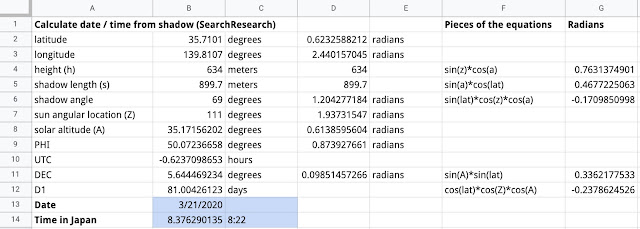Can you actually get the time and date from just a shadow?
This isn’t the post I thought I was going to make. As you’ll see, this has turned out to be much more complicated than I thought it would be. So I’m going to do this as a multi-part post–I’ll show you my working-out process. I’ll show you what worked, what didn’t, and what I learned along the way. Hope you’ll stick with me through the next couple of posts until we get this Challenge solved. Hope you’ll find this as fascinating as I do!
———–
In our last Challenge we met the SkyTree in Tokyo, Japan. (That is, 東京スカイツリー, Tōkyō Sukaitsurī) It’s a very tall tower in Tokyo that’s known around the world as a landmark.
And we saw its mighty shadow, extending from the base of the tower to just beyond the bridge over the Sumida river.
Our Challenge was simple:
1. What day and time-of-day was this photograph taken?
As always, I’m going to start with a simple, fairly open-ended query:
[ how to find time and date from shadow ]
which leads to a bunch of fascinating web pages, each of which tells us how to do exactly this. (Along with lots of details about the geometry and astronomy involved.)
A really useful summary of this calculation can be found on the Instructables site at “Time and Date of Satellite Maps.” On this page there’s a summary of how and why you can make this calculation.
When I wrote this Challenge, I knew about this “Time and Date of Satellite Maps” page and the computations involved. I figured that I’d just do the math, compute the answer, and call it a day. It turned out to be more complicated than that. But here’s what I did first….
TL;DR – over the course of the year, the sun moves throughout the sky on a figure 8 path called an analemma. If there was a tall tower standing, you’d see the tip of the tower trace the analemma on the ground. Like this:
 |
| P/C Petapixel showing the sun’s path across the sky each day. Filmed in Scotland using very clever pinhole cameras (the article is worth reading). |
What this means is that each shadow is unique… except for that one day of the year when the analemma crosses over itself–the sun on that day would cast the same shadow on two different days. (We’ll ignore this for the moment.)
The Instructables article gives both a satellite worksheet (to collect all the data), and the equations worksheet (to do all the math). Teachers: This is a great example of how to do a bit of trig with your class!
But the key to doing all this math is to first figure out:
1. the lat/long of the tower
2. the height of the tower
3. the length of the shadow
This is pretty simple to do with a quick search.
[ Tokyo Skytree ]
tells us that:
1. lat/long: 35° 42′ 36.36″ N, 139° 48′ 38.52″ E
(or in decimal form: 35.7101, 139.8107)
2. height: 634 m (2,080 ft)
And if we use Google Maps, we can measure the distance from the tower base to just-above the Shimada bridge by using the ‘measure distance’ feature in Maps:
3. shadow length: 899.7 meters (2951.9 feet)
We also need to measure the angle between the shadow and true north. In the map, north is straight up, so we can measure the angle by taking the image and drawing a vertical line. Here, I just drew a straight vertical line (to represent north), and then searched for an [ online protractor ] and pulled the image into that angle measurement tool:
 |
| You can read the angle of the shadow: 69° |
Now we can start to use the equations given in the article….
For the angle measurement, we are interested in where the Sun is located, which is exactly opposite the shadow. Measure the angle between due NORTH and the shadow of the landmark.
If the shadow is to the west of North, then the Sun’s angular location is:
Z = 180 – C
If the shadow is to the east of North, then the Sun’s angular location is:
Z = 180 + C
In our case, the shadow is to west of north, so:
Z = 180 – 69 = 111
To compute the solar altitude (A) with the length of the shadow (s) and the height (h) of the tower we can compute the altitude (A) of the Sun as:
A = Arctan(h/s)
In our case,
A = Arctan(h/s) = Arctan(0.70467) = 35.17 degrees
(Quick sanity check: looking at the figure, that seems about right. I believe that the sun is about 35 degrees above the horizon.)
How do we get the time of day? That requires a bit of math.
First we need to figure out PHI. That’s the angle of the sun along the line it follows across the sky. That line is called the “solar meridian.” PHI is a measure of how far along that line it is. It looks like this:
The value of PHI is given by this equation:
PHI = arctan( (sin(A) * cos(A)) / ( sin(A) * cos(lat) – (sin(lat) * cos(Z) * cos (A)) )
Once you have PHI for the sun’s location in the sky, and longitude of the tower, you can compute the time in UTC (Universal Time, Coordinated… which is basically Greenwich Mean Time). Here, both PHI and LONGITUDE are in decimal degrees.
The value of UTC is the number of hours after midnight.
UTC = 12h – (PHI + LONGITUDE)/15.04178
(note: If the landmark longitude is EAST then the longitude is subtracted from PHI. Luckily, ours is west. But here’s what you’d do if it were east.)
UTC = 12h – (PHI – LONGITUDE)/15.04178
Now…. How do we get the date?
The date is defined by which arc in the sky the Sun moves along between sunrise and sunset. To figure this out, we need to know the “declination,” (that is, how far above the equator the sun has risen) which we’ll represent as DEC. This is calculated from the measurements as:
DEC = ArcSin( sin(A)*sin(lat) + cos(lat)*cos(Z)*cos(A) )
With the DEC, you can calculate the Day of the Year the image was taken. There are two possible solutions:
D1 = 81 + (365/360)*Arcsin(DEC/23.44)
or
D2 = 81 + (365/360)*[180 – Arcsin(DEC/23.44)]
Note that the way these formula are written, the Arcsin function should be computed to return an angle in DEGREES not in RADIANS.
This gives a numerical day since the start of the year. To convert it into a date you can use an online numbered calendar. (Search for
At this point, if you’re like me, you’re thinking that this is a lot of math to do. What’s the best solution for such a problem? A: a spreadsheet. So I made one to organize all of the math. Here’s a link to my spreadsheet. And here’s what it looks like:
Note that column D has the values in radians (because the sin, cos, arctan functions all only use radians as inputs). But I also have all the values in degrees (column B) in case you don’t think in radians.
In any case, once I popped in the values, the spreadsheet did the computation, and out popped March 21, 2020 at 8:22AM.
Sanity check again: That’s springtime in Tokyo, cherry blossom season, and I’d expect the sun to be somewhat low in the southeastern sky, and casting a long shadow at 8:22AM towards the northwest. So I expect that at this time/date the shadow from Skytree would look just like the image. Hurrah!
But...…As always, I thought I’d check my work by finding another source of sun/shadow computation. I did a search for [ sun shadow calculations ] and discovered several different sun/shadow calculation tools….
I used the SunCalc tool to see what they predict the shadow of the Skytree to be on March 21, 202 at 8:21AM. Here’s what I found:
Something’s really wrong. That shadow isn’t anywhere near the bridge!
Indeed… what happened here? Since this post is already long, I’m going to write up my next steps in the next post (early next week). Stay tuned as we hunt for the shadow! (I’m going into all this depth because this is the kind of thing that happens when you’re doing slightly more sophisticated searches–things go wrong. I want to talk about the process of noticing the errors, and what you need to do to get back on track.)
Searching on!












